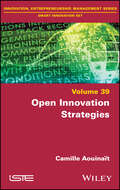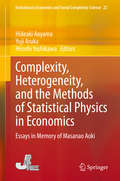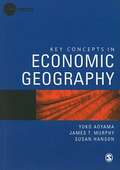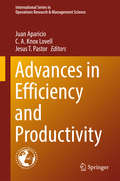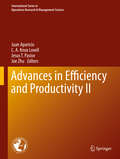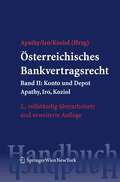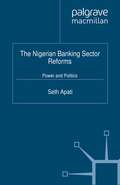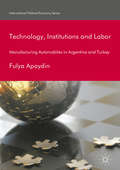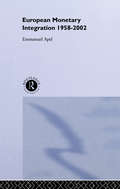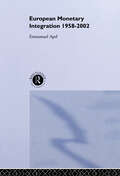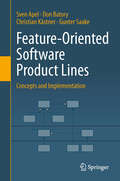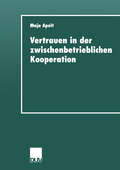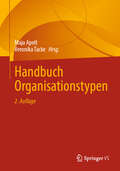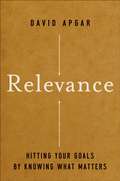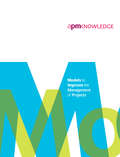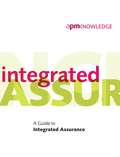- Table View
- List View
Open Innovation Strategies
by Camille AouinaitThe main aim of opening up innovation is to optimize the process of creating innovations, while pooling human, financial and material resources. Various profiles of actors are thus brought together in order to collaborate to achieve common objectives and share their particular interests.This book describes the challenges of collaboration in the development of innovations in a context where the sustainability of value chains is central. The diversity of collaborative forms, shared spaces (FabLab, LivingLab, co-working spaces), the intrinsic characteristics of innovation, and the actors actively involved in its emergence are all addressed in this book. The structuring of partners collaborating in innovative projects in specific environments is also discussed. Furthermore, it questions the social responsibility of companies and their innovative role in generating sustainable solutions for stakeholders.
Open Innovation Strategies
by Camille AouinaitThe main aim of opening up innovation is to optimize the process of creating innovations, while pooling human, financial and material resources. Various profiles of actors are thus brought together in order to collaborate to achieve common objectives and share their particular interests.This book describes the challenges of collaboration in the development of innovations in a context where the sustainability of value chains is central. The diversity of collaborative forms, shared spaces (FabLab, LivingLab, co-working spaces), the intrinsic characteristics of innovation, and the actors actively involved in its emergence are all addressed in this book. The structuring of partners collaborating in innovative projects in specific environments is also discussed. Furthermore, it questions the social responsibility of companies and their innovative role in generating sustainable solutions for stakeholders.
Complexity, Heterogeneity, and the Methods of Statistical Physics in Economics: Essays in Memory of Masanao Aoki (Evolutionary Economics and Social Complexity Science #22)
by Hideaki Aoyama Yuji Aruka Hiroshi YoshikawaThis book systematically provides a prospective integrated approach for complexity social science in its view of statistical physics and mathematics, with an impressive collection of the knowledge and expertise of leading researchers from all over the world. The book mainly covers both finitary methods of statistical equilibrium and data-driven analysis by econophysics. The late Professor Masanao Aoki of UCLA, who passed away at the end of July 2018, in his later years dedicated himself to the reconstruction of macroeconomics mainly in terms of statistical physics. Professor Aoki, who was already an IEEE fellow, was also named an Econometric Society Fellow in 1979. Until the early 1990s, however, his contributions were focused on the new developments of a novel algorithm for the time series model and their applications to economic data. Those contributions were undoubtedly equivalent to the Nobel Prize-winning work of Granger's "co-integration method". After the publications of his New Approaches to Macroeconomic Modeling and Modeling Aggregate Behavior and Fluctuations in Economics, both published by Cambridge University Press, in 1996 and 2002, respectively, his contributions rapidly became known and spread throughout the field. In short, these new works challenged econophysicists to develop evolutionary stochastic dynamics, multiple equilibria, and externalities as field effects and revolutionized the stochastic views of interacting agents. In particular, the publication of Reconstructing Macroeconomics, also by Cambridge University Press (2007), in cooperation with Hiroshi Yoshikawa, further sharpened the process of embodying “a perspective from statistical physics and combinatorial stochastic processes” in economic modeling. Interestingly, almost concurrently with Prof. Aoki’s newest development, similar approaches were appearing. Thus, those who were working in the same context around the world at that time came together, exchanging their results during the past decade. In memory of Prof. Aoki, this book has been planned by authors who followed him to present the most advanced outcomes of his heritage.
Key Concepts in Economic Geography (PDF)
by Yuko AoyamaKey Concepts in Economic Geography is a new kind of textbook that forms part of an innovative set of companion texts for the Human Geography sub-disciplines.
Advances in Efficiency and Productivity (International Series in Operations Research & Management Science #249)
by Juan Aparicio C. A. Knox Lovell Jesus T. PastorThis book grows from a conference on the state of the art and recent advances in Efficiency and Productivity. Papers were commissioned from leading researchers in the field, and include eight explorations into the analytical foundations of efficiency and productivity analysis. Chapters on modeling advances include reverse directional distance function, a new method for estimating technological production possibilities, a new distance function called a loss distance function, an analysis of productivity and price recovery indices, the relation of technical efficiency measures to productivity measures, the implications for benchmarking and target setting of imposing weight restrictions on DEA models, weight restrictions in a regulatory setting, and the Principle of Least Action.Chapters on empirical applications include a study of innovative firms that use innovation inputs to produce innovation outputs, a study of the impact of potential “coopetition” or cooperation among competitors on the financial performance of European automobile plants, using SFA to estimate the eco-efficiency of dairy farms in Spain, a DEA bankruptcy prediction model, a combined stochastic cost frontier analysis model/mixture hazard model, the evolution of energy intensity in nine Spanish manufacturing industries, and the productivity of US farmers as they age.
Advances in Efficiency and Productivity II (International Series in Operations Research & Management Science #287)
by Juan Aparicio C. A. Knox Lovell Jesus T. Pastor Joe ZhuThis book surveys the state-of-the-art in efficiency and productivity analysis, examining advances in the analytical foundations and empirical applications. The analytical techniques developed in this book for efficiency provide alternative ways of defining optimum outcome sets, typically as a (technical) production frontier or as an (economic) cost, revenue or profit frontier, and alternative ways of measuring efficiency relative to an appropriate frontier. Simultaneously, the analytical techniques developed for efficiency analysis extend directly to productivity analysis, thereby providing alternative methods for estimating productivity levels, and productivity change through time or productivity variation across producers.This book includes chapters using data envelopment analysis (DEA) or stochastic frontier analysis (SFA) as quantitative techniques capable of measuring efficiency and productivity. Across the book’s 15 chapters, it broadly extends into popular application areas including agriculture, banking and finance, and municipal performance, and relatively new application areas including corporate social responsibility, the value of intangible assets, land consolidation, and the measurement of economic well-being. The chapters also cover topics such as permutation tests for production frontier shifts, new indices of total factor productivity, and also randomized controlled trials and production frontiers.
Österreichisches Bankvertragsrecht: Band II: Konto und Depot (Springers Handbücher der Rechtswissenschaft)
by Peter Apathy Gert Michael Iro Helmut KoziolZu den grundlegenden Bankgeschäften zählen Verträge über die Errichtung eines Kontos oder eines Depots. Dabei handelt es sich gleichsam um die rechtliche Infrastruktur für zahlreiche andere Bankgeschäfte, wie etwa Giro- oder Kreditverträge oder den Handel mit Effekten für Kunden. Auch das Einlagengeschäft sowie die Bereitstellung eines Safes oder Tag- und Nachttresors gehören nicht nur zu den traditionellen Grundgeschäftsarten der Banken, sondern können thematisch zur Kontoführungs- und Verwahrungsfunktion der Bank in einem weiten Sinn gerechnet werden. Unter diesem Aspekt fasst der 2. Band die eben erwähnten Bankgeschäfte zusammen, wobei auch das Kontokorrent als typische Form der Abwicklung von Konten im Allgemeinen und in seiner besonderen Ausformung bei Girokonten in einem eigenen Kapitel behandelt wird. Das Kapitel über das Konto wurde wieder von Univ.-Prof. Dr. Iro, diesmal unter Mitarbeit von Dr. Zepke, bearbeitet. Die Abschnitte über das Kontokorrent und das Einlagengeschäft hat in dieser Auflage o.Univ.-Prof. Dr. Apathy, jenen über das Safegeschäft wie bisher o.Univ.-Prof. i.R. Dr. Koziol verfasst.
The Nigerian Banking Sector Reforms: Power and Politics (Palgrave Macmillan Studies in Banking and Financial Institutions)
by S. ApatiThis is the first comprehensive book on the politics and economics of financial sector consolidation in an emerging market in West Africa. It draws on the author's twenty years experience working with multinationals in this oil-rich zone, to address key issues and examine banking reform in one of the world's fastest-growing economies.
Technology, Institutions and Labor: Manufacturing Automobiles in Argentina and Turkey (International Political Economy Series)
by Fulya ApaydinIn this book Fulya Apaydin argues that labor responses to dramatic technological change are influenced by the political institutions of the Global South more than any other factor. In addressing vocational education programs – which are highly relevant in understanding how labor unrest is governed in developing settings – she makes two important contributions. Firstly, she offers a new theoretical framework to understand labor mobilization and de-mobilization patterns, rethinking vocational education as a key transmission belt for manufacturing labor consent. Secondly, she provides a systematic comparison of skill formation schemes and their implications on labor mobilization in federal and unitary systems. With a focus on Argentina and Turkey, two case studies are provided in which technology has provoked differing levels of strikes, walkouts and extended protest.
Technology, Institutions and Labor: Manufacturing Automobiles in Argentina and Turkey (International Political Economy Series)
by Fulya ApaydinIn this book Fulya Apaydin argues that labor responses to dramatic technological change are influenced by the political institutions of the Global South more than any other factor. In addressing vocational education programs – which are highly relevant in understanding how labor unrest is governed in developing settings – she makes two important contributions. Firstly, she offers a new theoretical framework to understand labor mobilization and de-mobilization patterns, rethinking vocational education as a key transmission belt for manufacturing labor consent. Secondly, she provides a systematic comparison of skill formation schemes and their implications on labor mobilization in federal and unitary systems. With a focus on Argentina and Turkey, two case studies are provided in which technology has provoked differing levels of strikes, walkouts and extended protest.
European Monetary Integration: 1958 - 2002
by Emmanuel ApelThis book is an accessible introduction to European monetary integration which provides a historical background to current debates, as well as an analysis of future developments. Further features of this book include: * a chronology of economic and monetary unification from 1958-1999 * clear non-technical presentation of the economic issues regarding the costs and benefits of creating a monetary union * detailed presentation of the economic and legal framework for the changeover to a single European economy * evaluation of the Maastricht Treaty's plan for monetary union * an overview of the debate between the federalist approach and the inter-governmental co-operation approach towards economic and political integration of Europe * a set of questions and exercises illuminating the more technical parts of the book European Monetary Integration 1958-2002 is an excellent resource for all those who want to discover the facts about European monetary integration which lie behind the heated political rhetoric.
European Monetary Integration: 1958 - 2002
by Emmanuel ApelThis book is an accessible introduction to European monetary integration which provides a historical background to current debates, as well as an analysis of future developments. Further features of this book include: * a chronology of economic and monetary unification from 1958-1999 * clear non-technical presentation of the economic issues regarding the costs and benefits of creating a monetary union * detailed presentation of the economic and legal framework for the changeover to a single European economy * evaluation of the Maastricht Treaty's plan for monetary union * an overview of the debate between the federalist approach and the inter-governmental co-operation approach towards economic and political integration of Europe * a set of questions and exercises illuminating the more technical parts of the book European Monetary Integration 1958-2002 is an excellent resource for all those who want to discover the facts about European monetary integration which lie behind the heated political rhetoric.
Feature-Oriented Software Product Lines: Concepts and Implementation
by Sven Apel Don Batory Christian Kästner Gunter SaakeWhile standardization has empowered the software industry to substantially scale software development and to provide affordable software to a broad market, it often does not address smaller market segments, nor the needs and wishes of individual customers. Software product lines reconcile mass production and standardization with mass customization in software engineering. Ideally, based on a set of reusable parts, a software manufacturer can generate a software product based on the requirements of its customer. The concept of features is central to achieving this level of automation, because features bridge the gap between the requirements the customer has and the functionality a product provides. Thus features are a central concept in all phases of product-line development. The authors take a developer’s viewpoint, focus on the development, maintenance, and implementation of product-line variability, and especially concentrate on automated product derivation based on a user’s feature selection. The book consists of three parts. Part I provides a general introduction to feature-oriented software product lines, describing the product-line approach and introducing the product-line development process with its two elements of domain and application engineering. The pivotal part II covers a wide variety of implementation techniques including design patterns, frameworks, components, feature-oriented programming, and aspect-oriented programming, as well as tool-based approaches including preprocessors, build systems, version-control systems, and virtual separation of concerns. Finally, part III is devoted to advanced topics related to feature-oriented product lines like refactoring, feature interaction, and analysis tools specific to product lines. In addition, an appendix lists various helpful tools for software product-line development, along with a description of how they relate to the topics covered in this book. To tie the book together, the authors use two running examples that are well documented in the product-line literature: data management for embedded systems, and variations of graph data structures. They start every chapter by explicitly stating the respective learning goals and finish it with a set of exercises; additional teaching material is also available online. All these features make the book ideally suited for teaching – both for academic classes and for professionals interested in self-study.
Vertrauen in der zwischenbetrieblichen Kooperation
by Maja ApeltDie Autorin zeigt, dass sich mit der Verschlankung und Virtualisierung von Zulieferbeziehungen ein Wandel des Vertrauens vollzieht, und weist auf verschiedene Typen von Vertrauensbeziehungen hin, an denen das ambivalente Verhältnis von Vertrauen und Macht deutlich wird.
Handbuch Organisationstypen
by Maja Apelt Veronika TackeDas Handbuch legt in seiner zweiten Auflage überarbeitete und aktualisierte Darstellungen einer Vielzahl von Organisationstypen aus allen Bereichen der Gesellschaft vor und ergänzt die bisherigen Beschreibungen noch um zahlreiche weitere.
Relevance: Hitting Your Goals by Knowing What Matters
by David ApgarIn this groundbreaking book, business guru David Apgar helps leaders pinpoint which information matters most for successful goal setting, strategy, and bottom-line performance. Based on simple and easy-to-implement practices, Relevance outlines a new discipline focused on the relevance of performance measures for assessing key strategy issues and accelerating learning. David Apgar’s practices are grounded in solid business research and clearly illustrated with real-life examples from top-performing companies such as Toyota, Alcoa, Nestlé, Capital One, Cisco, Microsoft, and GE.
Agile project management: a panacea or placebo for project delivery?
by ApmOn 7 July 2017, the Association for Project Management (APM), the Chartered body for the project profession, held an Agile Summit with its corporate partners, government bodies and key stakeholders to start the process of shaping the APM’s position on agile project management in the wider context of professional project delivery. Stimulated by input from practitioners and interested parties from the wide range of sectors who attended the event, this report aims to lay out key themes that drew a consensus. The event sought to focus on agile project management applied other than to ‘pure’ software development, and this discussion paper deliberately avoids the use of agile taxonomy. As the event was carried out under terms of full confidentiality, the specific detail of contributions is not being disclosed. All the examples shared at the event were of cases where agile project teams were assembled from inside the organisation concerned with internal clients. We encourage all those interested in how agile might impact their work and business to use this document to help inform debate within their organisations and networks. If you would like to contribute further to evolving this area of interest, please contact knowledge@apm.org.uk.
APM Project Fundamentals Qualification (PFQ) Exam Syllabus (PDF)
by ApmAPM Project Fundamentals Qualification (PFQ) Exam Syllabus PFQ is an introductory qualification that offers a fundamental awareness of project management terminology, offering a broad understanding of the principles of the profession.
APM Project Fundamentals Qualification (PFQ) Sample Paper (PDF)
by ApmAPM Project Fundamentals Qualification (PFQ) Sample Paper for the PFQ exam
APM Project Management Qualification (PMQ) Exam Syllabus (PDF)
by ApmAPM Project Management Qualification (PMQ) Exam Syllabus: PMQ is a knowledge-based qualification that allows candidates to demonstrate knowledge of all elements of project management.
APM Project Management Qualification (PMQ) Sample Paper (PDF)
by ApmAPM Project Management Qualification (PMQ) Sample Paper for the PMQ exam.
Building Sponsors (PDF)
by ApmA guide to project sponsorship Background Project sponsorship offers organisations huge opportunities when implemented successfully. While significant work has been undertaken to improve project performance via project delivery teams, little has focused on critical issues of sponsorship and leadership. This may be attributed to the sponsor’s role being hard to define and lacking traction in the boardroom. In 2015, APM ran an extensive research project investigating the Conditions for Project Success. The 12 conditions provide a conceptual framework against which real project delivery could be assessed. The research concluded that while the conditions were widely accepted as being integral to successful project delivery, they were infrequently applied and almost never in full. In five of those conditions, the project sponsor has the lead role. Sponsors’ Summit APM has committed itself to addressing this critical enabler of project success. In January 2018, APM held a Sponsors’ Summit with it's Corporate Partners, government bodies and key stakeholders to start the process of building a shared understanding of how to improve the sponsorship of projects, programmes and portfolios. The summit focused on real-world experiences from the wide range of sectors represented, and was undertaken under terms of full confidentiality. Building sponsors – future project leadership This report lays out key themes that drew a broad consensus. We encourage all those interested in how sponsorship might impact their work and business to use this document to help inform debate within their organisations and networks.
Chartered Project Professional (ChPP) Application Guidance (PDF)
by ApmChartered Project Professional (ChPP) Application Guidance
Models to Improve the Management of Projects
by ApmMany organisations look to standard models when trying to improve their project and programme management practice. This guide, written by some of the leading thinkers in the subject, provides independent and informed guidance on the main models currently in use and which are designed to improve the management of projects. Readers of this publication may also be interested in The Scheduling Maturity Model.
A Guide to Integrated Assurance
by APM Assurance Specific Interest GroupA Guide to Integrated Assurance enables organisations to improve the efficiency and effectiveness of their assurance activities. Written by APM’s Assurance Specific Interest Group, the guide identifies important roles and responsibilities as well as tools and templates to help overcome ‘silo-oriented approaches’ to assurance that do not naturally result in integration. It is aimed at project managers, sponsors (in particular, those responsible for designing and carrying out assurance activities) and stakeholders with an interest in the successful delivery of the projects, programmes or portfolios. Readers of this publication may also be interested in APM Introduction to Programme Management 2nd edition and Directing Change.
